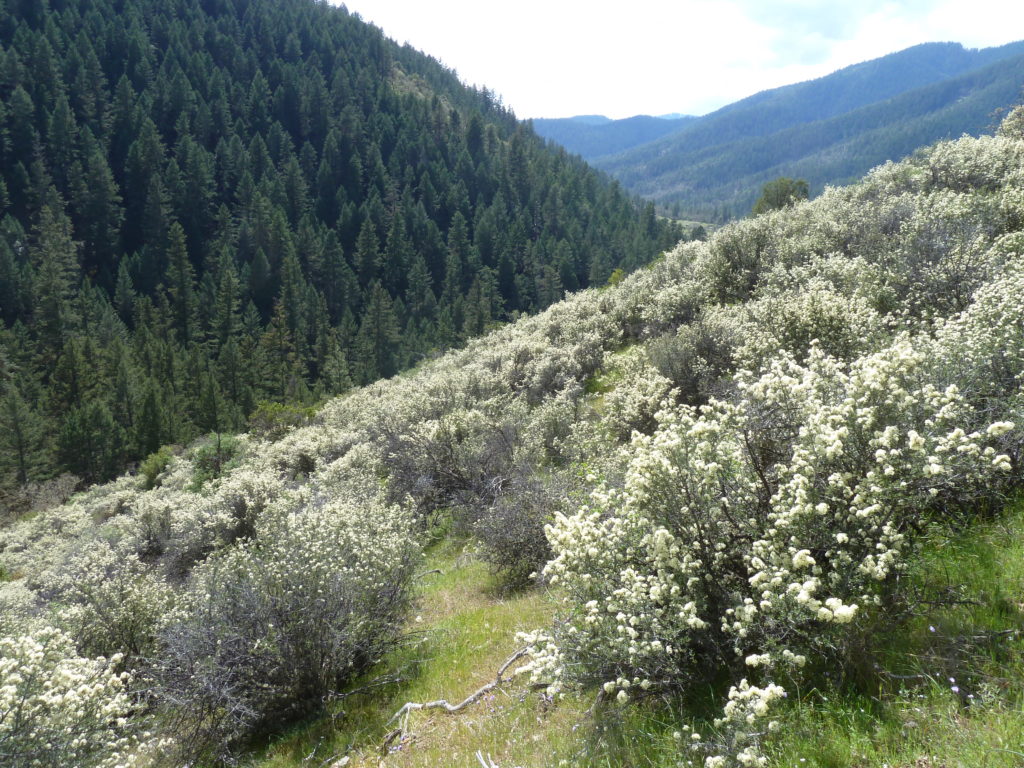
Chaparral is abundant in the Mediterranean habitats of California, where it grows from the Coast Range to the foothills of the southern Cascade and Sierra Nevada Mountains. It is a shrub dominated plant community characterized by drought tolerant species, with sclerophyllous leaves. Sclerophyllous leaves are hard, thick, leathery and generally evergreen. They provide adaptations to extreme heat and drought by shielding the leaf from intense sunlight and reducing water loss from evaporation. Although ubiquitous in California, chaparral is rather rare in Oregon, with its northern range extending into interior southwestern Oregon.
Located in the rain shadow of the Siskiyou Crest, the Applegate River watershed is the driest watershed west of the Cascade Mountains in Oregon. The region’s Mediterranean climate, fire history and extended summer drought also make it a significant center of chaparral habitat. Although found throughout the entire watershed, chaparral is most abundant in the Middle Applegate between Murphy, Applegate, and Ruch, on dry south and west facing slopes and at relatively low elevations. It is also abundant in the arid foothills of the Little Applegate Valley.
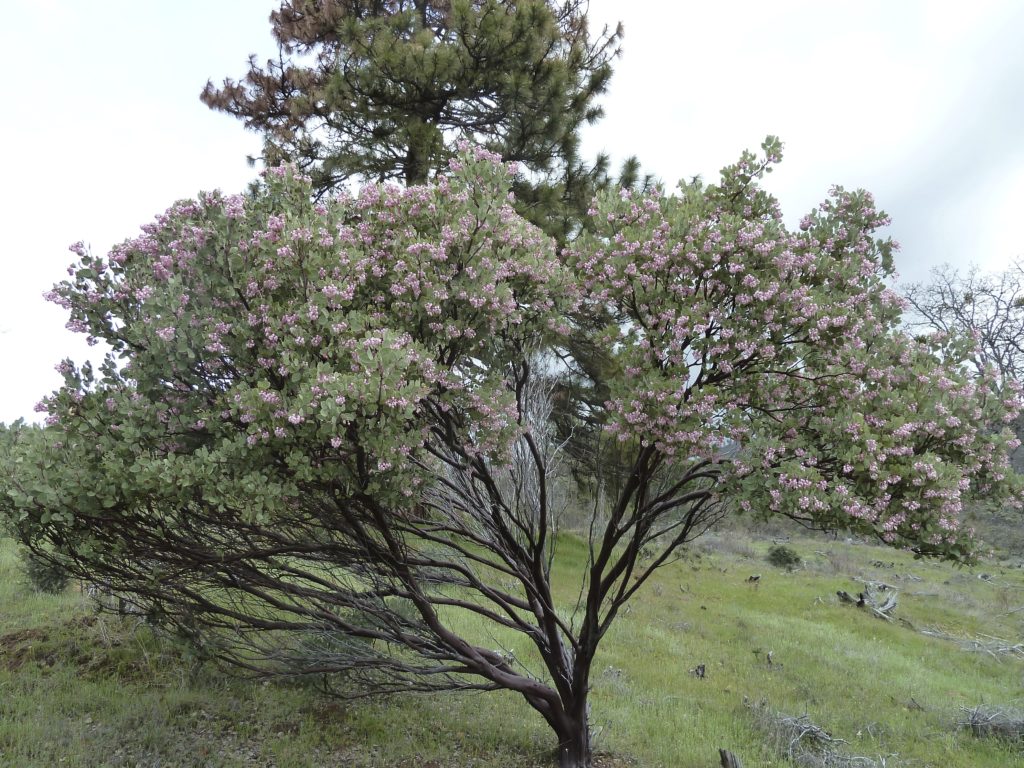
Often underappreciated, chaparral plays a unique and important role in the ecology of southwestern Oregon by providing cover for wildlife and song birds, important winter browse for deer and elk, habitat for native pollinators, as well as hosting numerous rare plant species. Chaparral also contributes significantly to our regional biodiversity, stabilizes soils, reduces erosion, and adds to the beauty of our landscape.
Southwestern Oregon interior valley chaparral often consists of whiteleaf manzanita (Arctostaphylos viscida), buckbrush (Ceanothus cuneatus), deer brush (Ceanothus integerrimus), yerba santa (Eriodictyon californicum) and silk tassel (Garrya fremontii), with varying amounts of white oak (Quercus garryana), stump sprouting madrone (Arbutus menziesii) and the occasional open grown Ponderosa pine (Pinus ponderosa) or thicket of knobcone pine (Pinus attenuata). In the Upper Applegate, isolated stands of redberry or hollyleaf buckthorn (Rhamnus ilicifolia) are found, creating the largest of two Oregon populations.

Although this northern chaparral population can be differentiated from populations further to the south by its more variable fire history, diverse fire effects, uneven-aged stand structure, and its ability to regenerate without fire, it is also very clear that chaparral is tied to fire for regeneration, to maintain its dominance, and to increase its vigor. More than adapted to wildfire, chaparral in southern Oregon and throughout its range is dependent on relatively infrequent high severity fire to renew, rejuvenate and maintain chaparral systems. In southern Oregon, the fire regime is mixed, but the mass, fire moderated regeneration is closely associated to high severity fire effects.

Chaparral ecosystems have a unique relationship with fire and require fire-free periods of sufficient time (20-30 years) to allow seed set. This allows seed obligates (non stump-sprouting species) such as whiteleaf manazanita, yerba santa and buckbrush to regenerate and thrive. Species such as silk tassel, greenleaf manzanita and others assert their dominance by sprouting vigorously after fire events. Irregardless of the reproductive strategy, chaparral is adapted to relatively infrequent fires and high severity fire effects.
In southern Oregon, fire suppression has limited fire activity in many chaparral habitats, but it does not appear to have significantly altered plant community structure or its relationship to fire. In fact, the concept of reducing fuel and limiting fire severity in chaparral habitats is contrary to its fire regime, fire history and natural history. Unless directly tied to community fire safety, fuel reduction in chaparral is entirely ineffective, unnecessary and environmentally damaging.

Currently, the largest threats to chaparral habitat in the Applegate Watershed are associated with the clearing of chaparral species and the conversion of natural chaparral habitats to non-native annual grasslands. This unfortunate conversion is often associated with so-called “restoration” treatments and/or fuel reduction projects. Currently this conversion is taking place most extensively on public lands, often far from homes, where it has little, if any effect on community fire protection, and where conservation values are particularly high.
Numerous scientific studies conducted in the Applegate Watershed by researchers at Oregon State University have documented the impacts associated with the widespread clearing of chaparral.

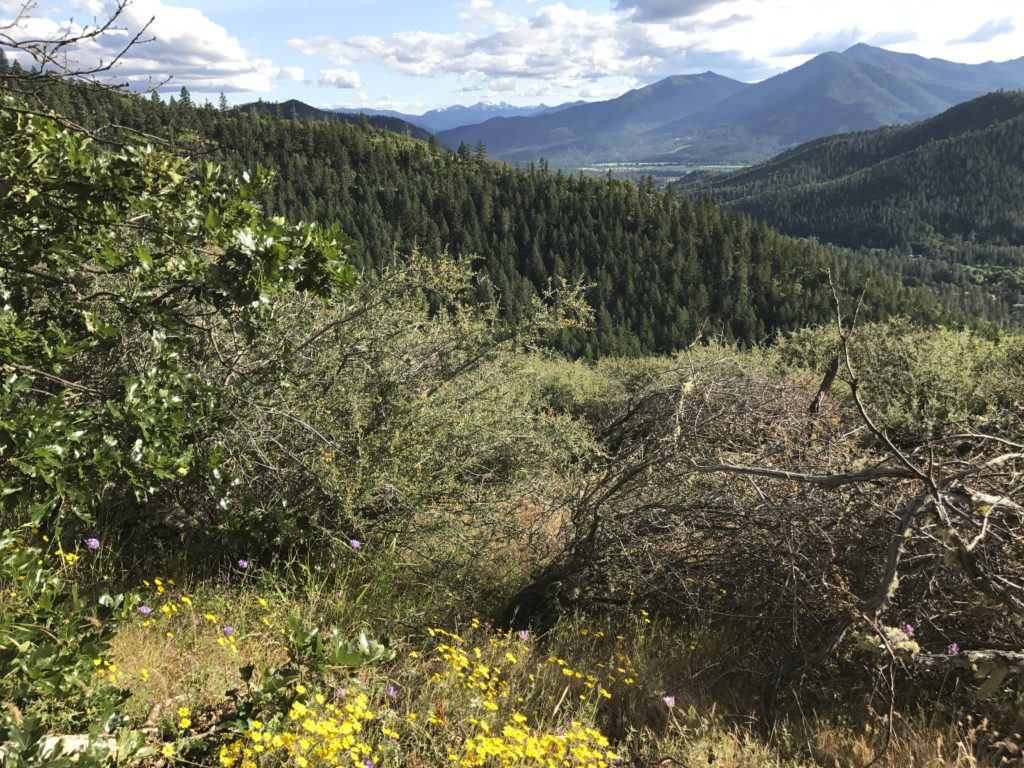
One study found that BLM fuel reduction treatments in the Applegate Watershed increased the abundance of non-native annual grasses (Perchemlides 2008). Species such as cheatgrass (Bromus tectorum) and medusa head grass (Elymus caput-medusae) tend to spread quickly following the removal of chaparral and heavily invade sites treated for fuel reduction. This conversion has also been shown to increase fire risks, alter fire regimes by creating more frequent fire events and permanently impact native plant communities.
Another study conducted in the Applegate Watershed specifically asked if BLM fuel reduction activities constitute “restoration” in chaparral ecosystems. The findings of this study demonstrate that “current fuel treatments may be incompatible with chaparral ecology and restoration.” The study found that large-scale chaparral clearing is detrimental in numerous ways, by reducing natural levels of chaparral cover, inhibiting chaparral regeneration and failing to mimic natural fire or age class mosaics on the landscape scale. (Duren. 2010).
Finally, it is highly likely that fuel reduction treatments in chaparral are not only damaging to the ecosystem, but also ineffective at reducing fire severity. Research conducted after the 2002 Squires Fire above Ruch and the Little Applegate Valley showed that previous fuel treatments in chaparral habitats had little to no effect on fire severity or vegetation mortality (Pfaff and Hosten).

In California, fuel reduction and habitat clearing is also frequently associated with the invasion of non-native annual grassland species. The spread of non-native annual grasses is altering native species composition, reducing chaparral cover, creating more frequent fires, hindering chaparral regeneration and converting important native ecosystems into heavily altered, predominantly non-native grassland habitats. The collapse of chaparral habitats in California has significant implications that are receiving some attention, but are largely ignored at the northern end of chaparral’s range in southwestern Oregon.
Given the impacts of clearing chaparral, researchers recommend, “leaving chaparral untreated except where fuel loads pose an unacceptable fire hazard to human life or property (e.g. along roads or below houses).” (Duren 2010).
Instead of responsibly managing chaparral, the Medford District BLM routinely degrades habitat far from homes, in the name of fuel reduction and even “restoration.” Recently, the BLM cleared vast swaths of mature whiteleaf manzanita in the lower Yale Creek Watershed. Crews cut, piled and burned nearly every manzanita on the hillside, leaving behind only white, sunbleached manzanita stumps and black, circular”charcoal pits” from extremely hot burn piles. These highly concentrated burns sterilize the soil, destroy native plants, cook off the soil seedbed and create persistent denuded sites subject to noxious weed spread for years after implementation.
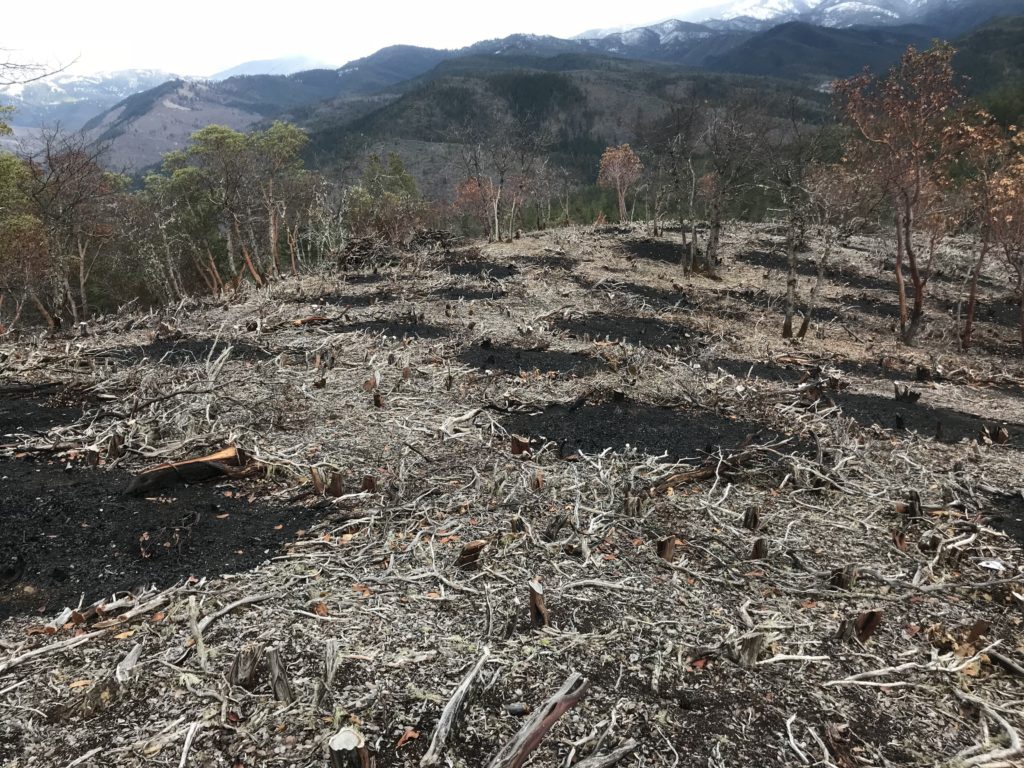
The so-called fuel reduction treatment on Yale Creek virtually eliminated the existing population of chaparral. The lack of broadcast fire, the removal of all chaparral seed sources, and the likely invasion of highly competitive cheatgrass, medusa head grass or hedgehog dogtail grass (Cynosurus echinatus) will inhibit the germination and growth of both chaparral and native herbaceous species. Clearing chaparral for fuel reduction does not just alter species composition by spreading non-native annual grasses, but these same grasses can also increase fire risks, fire frequency, rate of spread, and fire severity while degrading wildlife habitat.

Manzanita, in particular, provides abundant nectar flow for early season pollinators, including native bees and humming birds. It also produces abundant crops of little rust red berries. The berries are dry, tart, somewhat astringent, but rather tasty. Wildlife such as songbirds, small mammals, and especially black bears feast on these berries in the late summer, creating a critical food source in the midst of our extended summer dry season. Deer and other wildlife also often bed down in the shade and sleep in the shelter of manzanita at night. These habitats are important for wildlife, but are often eliminated in BLM fuel reduction treatments.

ANN encourages our federal land management agencies to consider the role of chaparral in our regional ecology. Scientific research conducted here in the Applegate Valley demonstrates the current strategy of clearing vast chaparral habitats through manual thinning and pile burning is detrimental, scientifically unsound, ineffective at reducing fire severity, and a colossal waste a taxpayer dollars.
Federal land managers should only conduct fuel reduction in chaparral habitats directly adjacent to homes and communities at risk. These treatments should retain large islands of chaparral and maintain interspersed oak, madrone and pine trees for habitat, while reducing density adjacent to existing homes. In more remote areas and away from homes, treatment is not beneficial or necessary.
Chaparral is not a wasteland. It is a unique and important ecosystem that can be conserved through largely passive management. We should be putting the limited fire mitigation dollars currently available near homes and communities that might benefit from well placed, highly strategic fuel treatments, not in remote locations with little bearing on community safety and in ecosystems that will only be degraded by our fuel management activities.
The unique northernmost populations of chaparral are more than just “brush” or “fuel” for the next fire. They are, in fact, diverse, vibrant and important ecosystems we should all embrace, celebrate and preserve in the Applegate Valley.

References:
Duren, Olivia & Muir, Patricia. 2010. Does Fuel Management Accomplish Restoration in Southwestern Oregon, USA, Chaparral? Insights from Age Structure. Fire Ecology Volume 6, Issue 2, 2010. https://link.springer.com/article/10.4996/fireecology.0602076
Perchmildes, Keith., Muir, Patricia., & Hosten, Paul. 2008. Responses of Chaparral and Oak Woodland Fuel Reduction Thinning in Southwestern Oregon. Rangeland Ecology Management 61:98-109. January 2008. https://bioone.org/journals/rangeland-ecology-and-management/volume-61/issue-1/07-026R1.1/Responses-of-Chaparral-and-Oak-Woodland-Plant-Communities-to-Fuel/10.2111/07-026R1.1.short
Pfaff, Eric & Hosten, Paul. Interaction of Squires Fire with Buncom Bowl Chaparral/Woodland Fuel Reduction Project, Applegate Valley, Southwestern Oregon. http://people.oregonstate.edu/~muirp/FuelsReductionSWOregon/ResearchReports/Research_WildfireEffects/Research_WildfireEffects.html

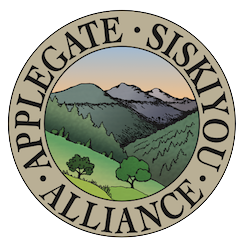
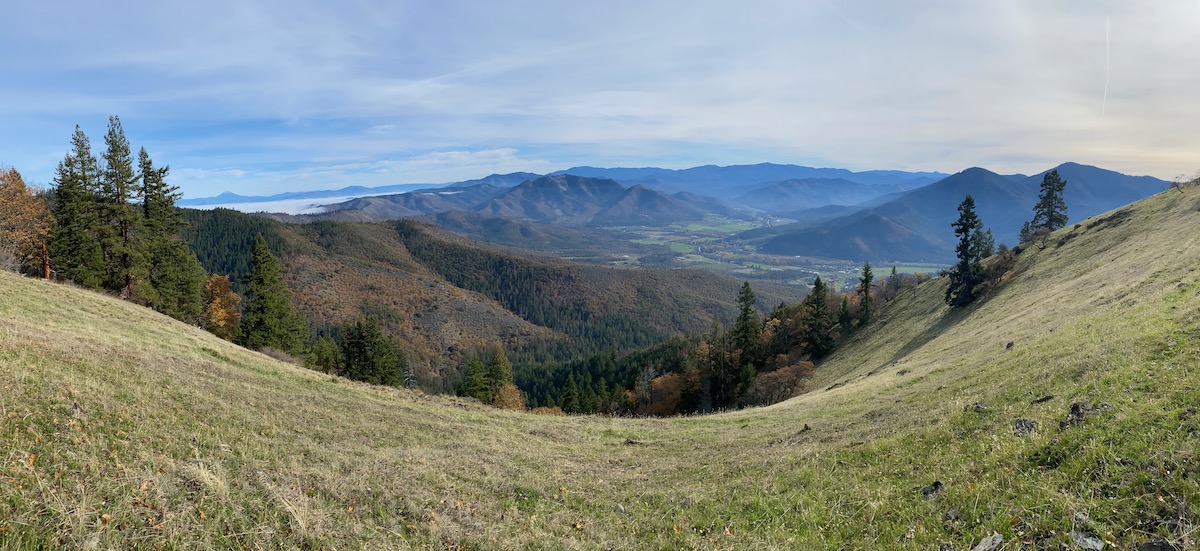
Wonderful article. Chaparral is almost never discussed, and the idea that it probably should not be thinned for fire prevention is very important. We have a hillside of manzanita above our property. We have been thinning madrone and firs between that chaparral and our home, and it is wonderful to get this information. We will let it be.